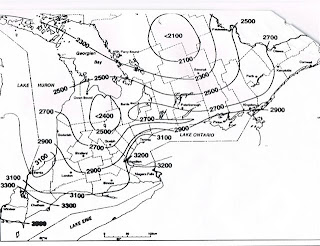The Ontario crop heat unit map was modified.
I know what you are thinking. "Who pays attention to the heat unit map when selecting corn hybrids? I haven't studied it for years." I agree because the map didn't change for many years, but now it has. And while growers may not look at the map very often, over the course of my career it has been the basis for a lot of decisions. Depending on your point of view, you have used it to either back up your hybrid choices or to ridicule the neighbour for foolishly growing hybrids too late for your area.
Dr Murray Brown at the University of Guelph was the driver behind the heat unit calculation in Ontario based on max and min temperatures. It was outstanding research that has benefited corn growers in Ontario and has been widely proven to be the most reliable indicator of heat accumulation with respect to corn growth.
Here is the old chart that was in use up until 2009. The new one is directly underneath.
My apology for the quality of the new map, but there is an approximate 200 heat unit difference from old to new. The 2900 heat unit line in the old map is now shown to be a 3100 heat unit line. The two maps were produced from the same sets of temperature data. Why the change?When the first map was produced the heat unit calculation did not start until there were 3 consecutive days of average temperature greater than 12.8 degrees C. This produced annual starting dates ranging from early to late May, which in the 70's was an accurate planting date predictor. When I was a young lad, corn was rarely planted before the Victoria Day weekend in May.
The new map is calculated using May 1 as the starting date. The old 3 consecutive warm days calculation was discarded because now we are very used to having corn planted by May 1. A typical May early day can deliver 10-13 heat units, which when multiplied over 15-20 days equals 200 heat units.
May 1 has become a standard planting date not due to global warming, but because of the following factors.
1. Tile drainage - more fields are systematically tiled which means more fields are fit to plant earlier
2. Seed Treatments - seed treatments today keep seed viable for up to a month in cold soil. 15 years ago, 2-3 weeks was the max.
3. Experience with early planting dates - we have learned a lot about tillage and seed placement over the years which helps us get corn out of the ground when it is cool. We have also learned about frost effects on young seedlings and have lost some of our fear.
4. Speaking of young seedlings, breeders have improved the cold tolerance of hybrids by planting their research plots early and selecting for the strongest survivors.
What does this mean? It means we all need to take time to re-evaluate our thinking with respect to maturity. Experiment. On those early fields, try a hybrid that you would consider to be too long for the area. You may find the map to be correct.


No comments:
Post a Comment